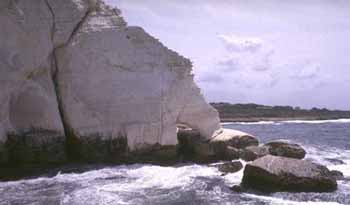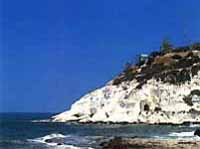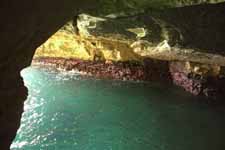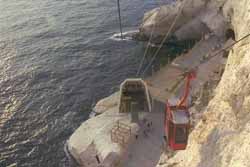Rosh Hanikra
Rosh Hanikra is in the northwestern corner of Israel, on the border of Israel and Lebanon. The white chalk cliffs offer a spectacular panoramic view of Haifa Bay, the hills of the Galilee and the Mediterranean Sea.
The book of Joshua (13:6) mentions "Misraphot Mayim" south of Rosh Hanikra, as the border of the Israelite tribes during the 14 -13 centuries BCE. Jewish sages referred to the cliff as "The Ladder of Tire." The Muslim conquerors renamed the area A-Nawakir (the grottoes). The present name, Rosh Hanikra, is a hebraicized version of the Arabic Ras-A-Nakura. In ancient times, Rosh Hanikra was along the trade route between the northern civilizations in Lebanon and Syria and the southern ones in Palestine, Egypt and North Africa. The place was then known as "the Ladders of Tyre." It has been the gateway in and out of Palestine since ancient times. In 333 Alexander the Great entered the Land of Israel through Rosh Hanikra, and is believed to have led his Greek army through a tunnel his forces dug in these cliffs.
The British army invaded Lebanon from this direction during the two world wars as did Israeli forces in the late 70's and early 80s. During World War II, the British dug a tunnel for the railway running between Haifa and Beirut to facilitate the movement of supplies from Egypt to the north. When the British withdrew in 1948, Israeli forces took over Rosh Hanikra and the Palmach blew up the railway bridges in the grottoes to prevent the Lebanese army from invading from that direction when the War of Independence began. During the Lebanon War, you could watch lines of Israeli tanks along the border preparing to cross and jeeps with UN peacekeepers observing the movements.
The grottoes of Rosh Hanikra were formed by the sea chipping awaw portions of the soft chalk rock over thousands of years. In 1968, a tunnel was dug from the shore to the natural grottoes. The tunnel was constructed slightly above the sea surface. It is 400 meters long and took two years to complete. A cable car leads to the shoreline where visitors can explore the grottoes. It is possible, though not advised, to swim in the grottoes, which are inhabited by bats, loggerhead sea turtles, sea birds and other wildlife. The place is a part of the Achziv Natural Reserve. |
| Previous | Next |







